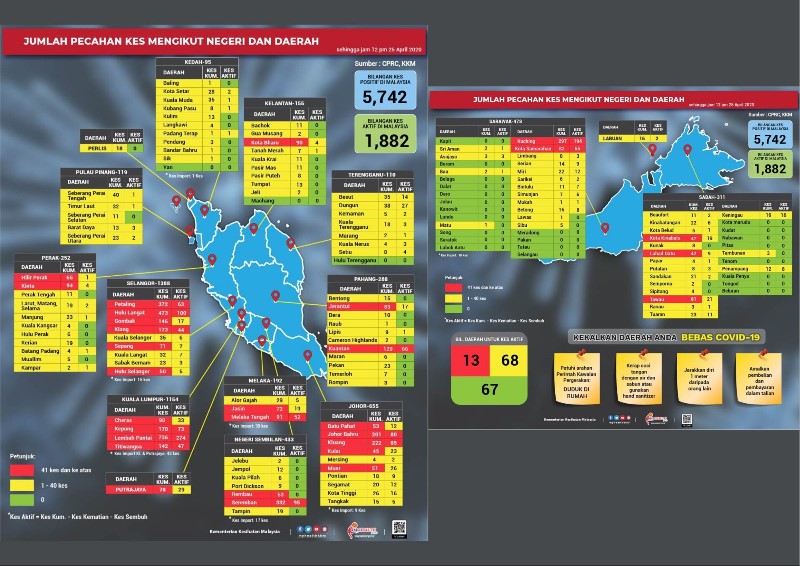KUALA LUMPUR, April 27 — An epidemiologist has suggested extending the Movement Control Order (MCO) from May 12 until after Hari Raya falls late next month, making the lockdown at least 10 weeks’ long.
Dr Nirmala Bhoo Pathy, a public health medicine specialist and associate professor of epidemiology at Universiti Malaya, said both Muslim and non-Muslim Malaysians would be inclined to participate in gatherings during the Muslim fasting month — like prayers, buka puasa, and other social events — if the nationwide partial lockdown is lifted on May 12, ahead of Hari Raya that falls on May 24.
“Ramadan is the game changer,” Dr Nirmala told CodeBlue in an interview yesterday.
“While I have a heavy heart about this prolonged MCO, I still think it is a necessary evil,” she said. “Lifting an MCO during Ramadan may be disastrous.”
The epidemiologist recommended extending the MCO until after the Hari Raya “mood” is over, even as she acknowledged significant economic losses and collateral damage from other social determinants of health.
The Edge reported Friday foreign research house UOB Kay Hian Research as saying that a long MCO period — which was first imposed on March 18 and expected to be extended until after Hari Raya — could lead to a possible recession and a spike in Malaysia’s unemployment rate well beyond a 4 per cent baseline.
European countries have begun to slowly reopen, CNN reported last April 11, even though a World Health Organization (WHO) official said now was not the time to relax lockdown measures, as seven of the 10 worst hit countries by the Covid-19 pandemic are in Europe.
BBC reported that Norway would start to scale back lockdown measures from April 20 by reopening kindergartens first, and then schools a week later, after imposing containment measures in mid-March. Sweden, unlike other European countries, did not implement a full lockdown, but BBC reported that the vast majority of the 10-million population voluntarily followed social distancing measures.
“The Scandinavians don’t need laws to control them,” Dr Nirmala said.
“They are socially responsible and will do the right thing because they know the consequences. In our society, we have people who put up posts on social media on the importance of physical distancing and staying at home, while flouting the rules.”
When asked if Malaysia could lift the MCO on certain zones or areas after May 12, should they report zero new Covid-19 cases for a period of time, Dr Nirmala opposed decentralising lockdown measures.
“Imagine one place where people are free to move during Ramadan and in another place, you can’t,” she said. “It will turn into political chaos”.
Lessons From 1918-1919 Flu Pandemic

Dr Nirmala cited public health measures implemented during the Spanish flu pandemic of 1918 that had infected about one-third of the world’s population and killed an estimated 40 million people globally, including 550,000 individuals in the United States (US). The Covid-19 pandemic has so far infected over 2.9 million people globally and caused over 203,000 deaths.
“If you look at the Spanish flu, states which imposed combined forms of public health measures for 10 weeks were most successful,” Dr Nirmala told CodeBlue.
The epidemiologist quoted a 2007 study by Dr Howard Markel, Harvey Lipman, and J. Alexander Navarro that analysed social distancing measures during the 1918-1919 influenza pandemic — such as isolation of the sick and quarantine of people suspected of being in contact with the infected; school closures; and banning public gatherings — in 43 US cities.
The research found that cities which implemented safe distancing actions earlier reported greater delays in reaching peak mortality, lower peak mortality rates, and lower total fatalities from the flu. The study also highlighted a link between increased duration of social distancing measures and fewer total deaths.
New York City reacted earliest to the flu crisis and imposed strict mandatory isolation and quarantine measures for more than 10 weeks starting September 19, 1918, as well as staggered business hours for about a month that year. According to the study, New York City experienced the lowest fatality rate on the Eastern seaboard.
St Louis — which implemented various public health measures relatively early, including closing schools and cancelling public gatherings for about 10 weeks — ranked seventh out of the 43 cities in the study on the rate of excess pneumonia and influenza deaths. (A higher ranking has a lower mortality rate).
The study concluded that cities with an earlier public health response and “the most sustained and most days” of safe distancing measures had much smaller death rates from the flu, as it observed that a majority of the 43 US cities experienced a second mortality peak after lifting such interventions.
States Without New Covid-19 Cases For Over A Week

Perlis, Perak, and Kelantan, and the federal territory of Labuan, have recorded zero new Covid-19 cases for at least nine consecutive days, as of yesterday. Perlis hit 12 days free of new reported Covid-19 infections, followed by Kelantan at 10 days, and Perak and Labuan at nine.
Penang previously recorded 11 days free of new Covid-19 cases, until the northern state reported two new infections yesterday, but it is unknown where these cases were detected. The Ministry of Health (MOH) has not published more granular data on the locations of new coronavirus cases confirmed daily.
Kedah and Terengganu also may have districts or sub-districts with at least 14 days free of new coronavirus cases. Kedah reported zero new Covid-19 cases daily from April 10 to April 26, except for one new case detected on April 15 and another new case detected on April 22. Meanwhile, Terengganu recorded zero new Covid-19 cases a day from April 12 to April 26, except for four new infections on April 13, two on April 16, one on April 18, and one on April 23.
According to figures released by MOH, certain districts have never reported any Covid-19 cases at all throughout the epidemic that broke out in Malaysia last January, like Yan (Kedah), Machang (Kelantan), Hulu Terengganu (Terengganu), as well as 15 districts in Sarawak and eight in Sabah.
Former Health deputy director-general Dr Lokman Hakim Sulaiman told CodeBlue recently that the MCO should be lifted in areas — be it sub-districts (mukim) in rural areas, or smaller zones or sections in the cities — that have not reported new Covid-19 infections for over 28 days,with such “white” areas protected by strict border controls.
CodeBlue asked MOH what kind of metrics it was using to measure progress on its six conditions in ending the MCO, such as how it defined controlling Covid-19 transmission and if this was evaluated by setting a minimum number of days free of new reported infections. MOH was also asked if the lockdown exit strategy included lifting the MCO in certain areas first.
Health director-general Dr Noor Hisham Abdullah simply told CodeBlue: “Wait for PM to announce”.








